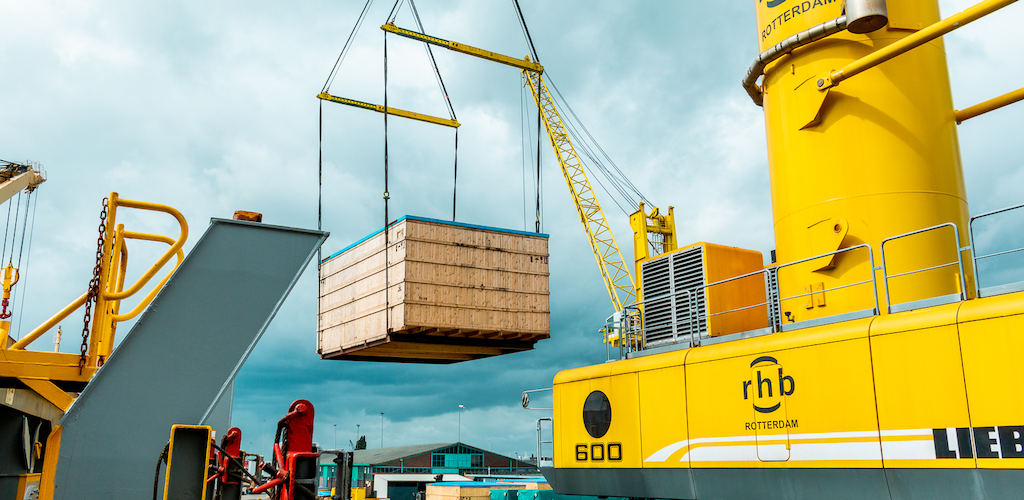Segment ‘Gaining in Importance' on Way to Record Year

Port of Rotterdam authorities reported resurgent breakbulk throughput for the third quarter, surpassing 2019 levels, but caution that volatile market conditions may prevail for some time to come.
For the first nine months of the year, the port handled 5 million tonnes under the "other general cargo" category, a rise of 14.4 percent compared to 2020, and 3 percent above the 4.9 million tonnes handled in 2019, the port’s all-time record year. This category was dominated by incoming non-ferrous, steel, forest products and heavy-lift and project cargo, with 3.5 million tonnes received and 1.6 million tonnes outgoing.
“Rotterdam has the breakbulk segment high on the agenda,” Twan Romeijn, the port's business manager for breakbulk and offshore industry told Breakbulk. “Not only due to the throughput and investments being made in among other expansions, new equipment and sustainable solutions sustainability, but also due to the fact that the breakbulk segment is of great importance to Rotterdam in terms of added value and employment.”
Upward Path
The port's overall breakbulk total reached 23 million tonnes, compared with 21.5 million tonnes in 2020. This included roll on/roll off throughput of 18 million tonnes, up 5.2 percent on the same period last year, and equivalent to a 7 percent increase.
“The main driver for growth was the loading/discharging of non-ferrous metals and steel,” Romeijn said. “Large amounts of non-ferrous and steel are being handled in the port of Rotterdam, due to a large demand for raw materials, such as plates, coils, pipes, billets etc. This is either for storage or transportation to the hinterland as input for markets such as automotive, construction and machinery.” Next to that the handling of forest products remained stable and we saw a slight increase in project cargo being handled.
Overall Rotterdam saw total goods throughput rise to 350.1 million tonnes in the first three months, up 8.6 percent compared to the same period last year. Strong growth was reported in nearly all segments, with particularly robust performance in iron ore and scrap metal which was up 42 percent, mineral oil products were up 13.5 percent, coal up 48.4 percent, biomass up 18.7 percent, and containers up 4 percent in tonnes. Agribulk and LNG were the main losers, down 12.8 percent and 1.8 percent, respectively.
“These quarterly figures show that the economy is continuing its upward path. The whole world was in lockdown last year because of the corona pandemic. Now factories, businesses and logistics are operating flat out again to meet increased demand,” said Allard Castelein, CEO of the Port of Rotterdam Authority.
Heavy-lift and project cargo for the wind power sector is seen as a key element in this increased demand as new wind farms drive SIF load-out of monopiles/transition pieces and other outsized components, such as blades and tower sections, also transit Rotterdam.
Investment in New Generation of Skills
Despite the positive figures, officials warns that acute shortages in some links of the global logistics chain may still dampen growth and highlight the importance of investing in “good jobs for current and future generations” at the port as well as “investing in the transition to a more sustainable energy system, with more green hydrogen and lower carbon emissions.”
This focus on job creation and skills is expected to be positive for the breakbulk segment moving forward as the bespoke alliances necessary for project cargo handling create unique value for the port. Romeijn reinforces this point, noting that “breakbulk is a true market were ‘hands’ are needed and where cooperation is needed to get the job done. Especially in project cargo this is the case where multiple companies work on one project (floating cranes, equipment providers, calculators, stevedoring companies, lashers etc. etc.). As added value and employment is growing in attention for the whole port, breakbulk is gaining in importance as well, which further stimulates investments and prioritizing.”
The port of Rotterdam is one of the largest breakbulk hubs in Europe and operates the biggest fleet of sheerlegs, and land and floating cranes on the continent.
Infrastructure Innovation
Alongside investment in skills, the port has identified the energy transition and digitalization as twin pillars for growth this year and next, and the port authority reports that 80 percent of the 230,000 annual port calls the harbor master receives are now automated.
“Rotterdam-based terminals are further developing themselves in term of sustainability, new equipment, new storage possibilities which will have a positive impact on the breakbulk activity in Rotterdam,” Romeijn explained, adding that the port will also host Breakbulk Europe 2022, which “hopefully results in new business as visitors can see the strength of Rotterdam in real life.”
In September, the port installed the world's first 3D-printed steel bollards on the new quay in the Sleepboothaven at Rotterdam Heijplaat as part of its infrastructure innovation program in which the port authority aims to improve the construction and use of port infrastructure and make it more sustainable by means of scientific research, innovation and digitalization.
Looking to the future, Romejin explains that the outlook for 2022 is "rather difficult to predict," given the current market, under pressure from many factors such as Covid, raw material prices, raw material supply and demand, and the impact of sustainability. Despite this volatility, Romejin notes “we expect 2022 to be rather similar to 2021, with a slight increase in volume due to the fact that the first three months of 2021 were impacted by Covid.
